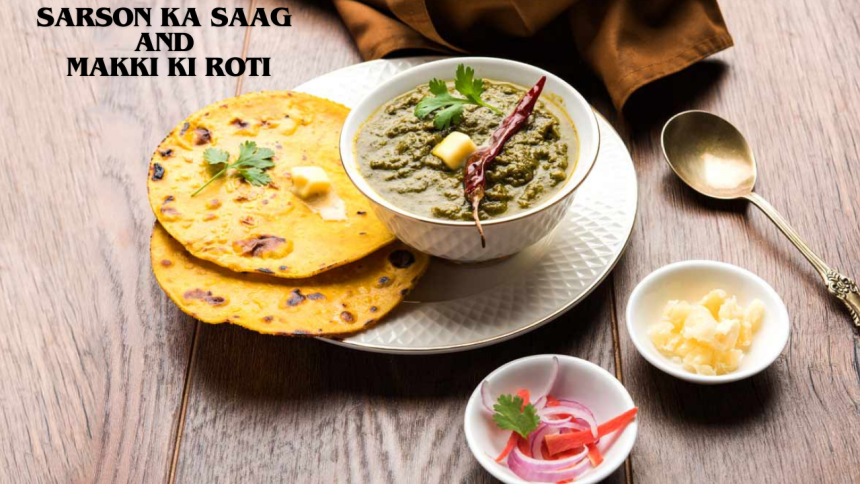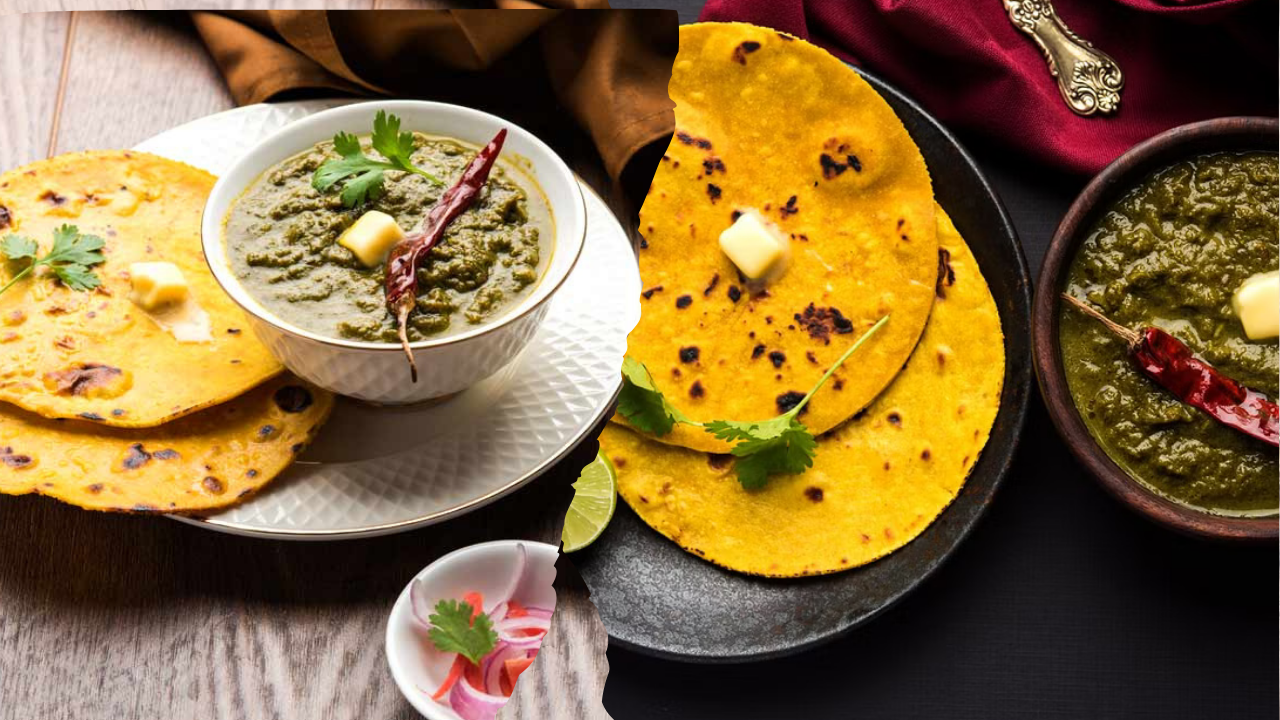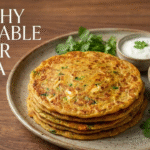Some dishes are more than fair food—they’re an involvement, a bequest passed down through eras. Sarson Ka Saag and Makki Ki Roti epitomize the warmth, adore, and rural charm of Punjabi cooking. This conventional winter delicacy is not fair around taste; it’s approximately convention, culture, and the farm-to-table reasoning that has been imbued in Indian families for centuries. Let’s take a profound plunge into the enchantment of this generous feast and find what makes it so special.
The Roots of Sarson Ka Saag and Makki Ki Roti
Sarson Ka Saag (mustard greens curry) and Makki Ki Roti (cornmeal flatbread) have their roots profoundly implanted in the agrarian way of life of Punjab. Agriculturists would plan this wholesome dish utilizing new create from their areas, making it a staple amid the cold winter months.
Why is it a Winter Favorite?
Mustard greens flourish in winter, making them an perfect regular ingredient.
The dish gives warmth and vitality, basic for persevering the cruel North Indian winters.
It’s stuffed with supplements that reinforce insusceptibility and boost by and large health.
The Farm-to-Table Concept: A Convention in Each Bite
Long some time recently farm-to-table got to be a in vogue concept, Indian family units, particularly in provincial Punjab, were as of now practicing it. Families would collect mustard greens from their ranches, pound maize for the roti, and cook everything fresh.
What Makes It Special?
Freshly culled mustard takes off bring an unmatched gritty flavor.
Home-ground maize flour guarantees a wholesome, nutritious meal.
The slow-cooking prepare upgrades flavors and jam nutrients.
Fixings That Make the Enchantment Happen
While the dish sounds basic, its flavors are a result of carefully chosen fixings that complement each other beautifully.
For Sarson Ka Saag:
Mustard greens (Sarson) – The legend of the dish, advertising a marginally biting, peppery taste.
Spinach & Bathua (Chenopodium) – Included for a smoother surface and additional nutrients.
Garlic & Ginger – Basic for their fragrant and stomach related benefits.
Green Chilies – Bringing in fair the right sum of heat.
Makhan (White Butter) – A liberal spot includes abundance and authenticity.
For Makki Ki Roti:
Makki Atta (Cornmeal) – Gives the bread its signature grainy texture.
Warm Water – Makes a difference tie the batter and make it pliable.
Ajwain (Carom Seeds) – Improves absorption and includes a unpretentious flavor.
Ghee – For cooking and brushing on best for additional taste.
The Cooking Handle: Moderate and Soulful
The planning of Sarson Ka Saag isn’t surged; it’s a labor of adore. The greens are washed altogether, bubbled, and at that point slow-cooked with flavors until they turn into a thick, flavorful curry. A last tadka (treating) of ghee, garlic, and chilies gives it a tantalizing aroma.
Makki Ki Roti, on the other hand, requires ability and persistence. Not at all like wheat flour, maize flour needs gluten, making it troublesome to roll out. Customarily, the mixture is straightened utilizing hands or maybe than a rolling stick, and each roti is cooked on a hot griddle with ghee until brilliant brown.
Wholesome Benefits: A Powerhouse of Goodness
Beyond the overwhelming taste, this dish is stuffed with wellbeing benefits.
Why Is It So Great for You?
Rich in Fiber: Helps assimilation and keeps you full longer.
Loaded with Press & Calcium: Fundamental for bone wellbeing and avoiding anemia.
High in Cancer prevention agents: Mustard greens are known to boost resistance and battle free radicals.
Good Fats from Ghee & Butter: Give vitality and upgrade supplement absorption.
The Idealize Matching: Lassi and Gur (Jaggery)
A genuine Punjabi dinner is deficient without its idealize companions. Sarson Ka Saag and Makki Ki Roti are regularly delighted in with a glass of chilled Lassi (buttermilk) or a chunk of Gur (jaggery).
Why This Combination?
Lassi helps absorption and equalizations the meal’s richness.
Gur acts as a characteristic sweetener and gives moment energy.
The differentiate of flavors—spicy saag, natural roti, and sweet jaggery—is basically divine.
Sarson Ka Saag and Makki Ki Roti Over Borders
While this dish is synonymous with Punjab, its varieties can be found in distinctive parts of the world. Comparable dishes exist in Nepal, Pakistan, and indeed among Indian communities overseas who keep their nourishment conventions alive.
Global Variations:
In Pakistan, it’s frequently matched with spiced pickles and buttermilk.
In Nepal, mustard greens are too a staple in numerous households.
Indian eateries around the world have presented this dish to a worldwide audience.
The Merry Association: Lohri & Celebrations
Sarson Ka Saag and Makki Ki Roti are necessarily to the Lohri celebration, a Punjabi celebration that marks the conclusion of winter and the onset of longer days.
Lohri Devour Highlights:
Families assemble around campfires, getting a charge out of this dish with people music and dance.
It symbolizes thriving, warmth, and appreciation for the harvest.
Served with sesame seeds, peanuts, and rewari (a crunchy sesame sweet).
Bringing It Domestic: Making Sarson Ka Saag & Makki Ki Roti
Want to attempt this enchantment at domestic? Here’s a speedy guide:
Steps for Sarson Ka Saag:
Boil mustard greens, spinach, and bathua until soft.
Mash them well and slow-cook with garlic, ginger, and spices.
Add maize flour to thicken and improve texture.
Finish with a hardening of ghee, garlic, and ruddy chilies.
Steps for Makki Ki Roti:
Knead cornmeal with warm water and ajwain.
Take little parcels and smooth them utilizing hands.
Cook on a hot griddle, flipping carefully.
Brush with ghee and serve hot.
The Enthusiastic Association: More Than Fair Food
For numerous, this dish isn’t fair around flavors—it’s around sentimentality, family social occasions, and cherished minutes. The smell of saag stewing on the stove, the warmth of naturally made roti, and the giggling around the feasting table make an involvement that remains with you forever.
Read More: The Most prominent Places to Visit in Gangtok for Nature, Trade, and Culture
Conclusion
Sarson Ka Saag and Makki Ki Roti are more than fair a Punjabi meal—they’re a celebration of convention, wellbeing, and the basic delights of life. From farm-fresh fixings to profound cooking, each chomp tells a story of legacy and cherish. Whether you’re getting a charge out of it in a town in Punjab or cooking it in your present day kitchen, the enchantment of this dish remains ageless. So, why not bring a small Punjab into your domestic and savor this provincial enchant nowadays?









